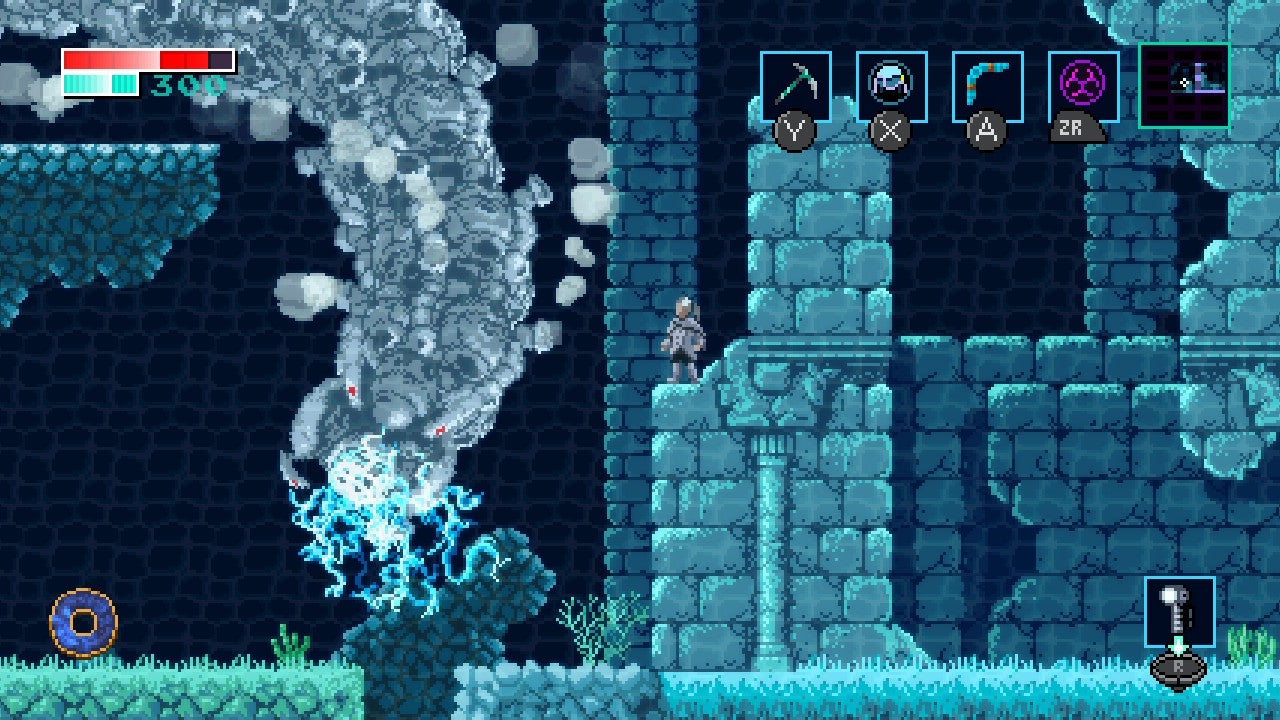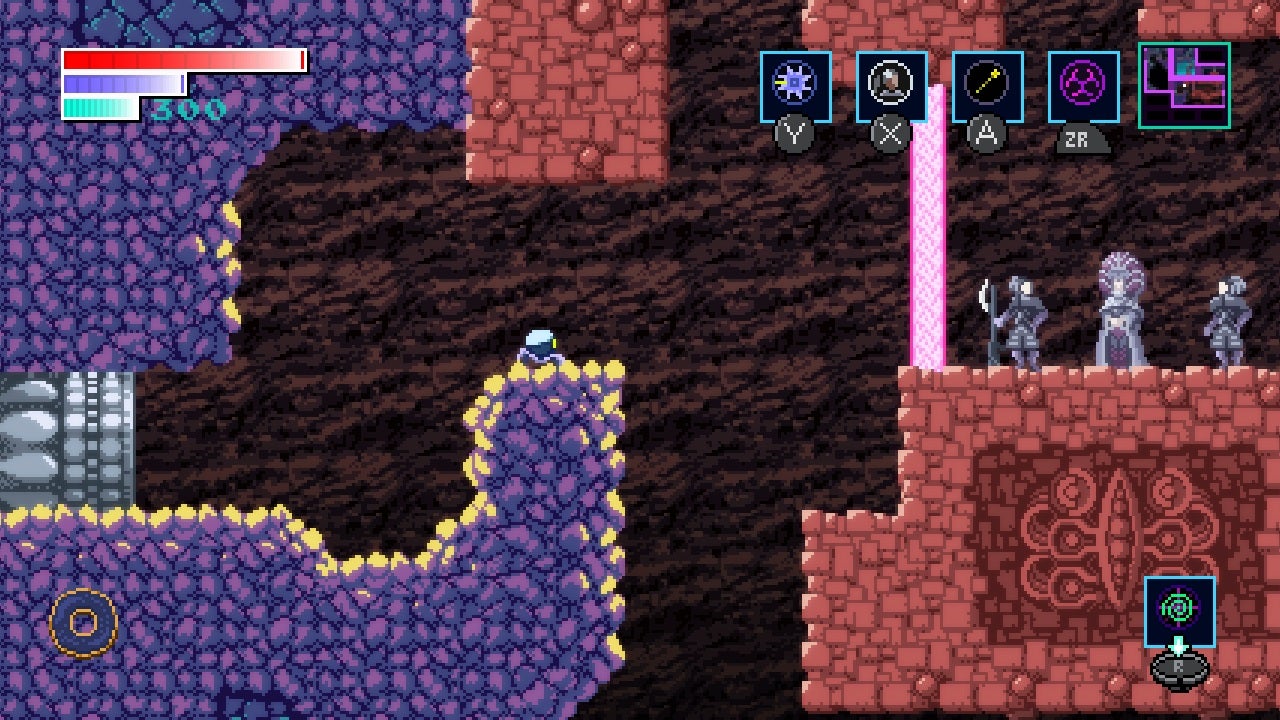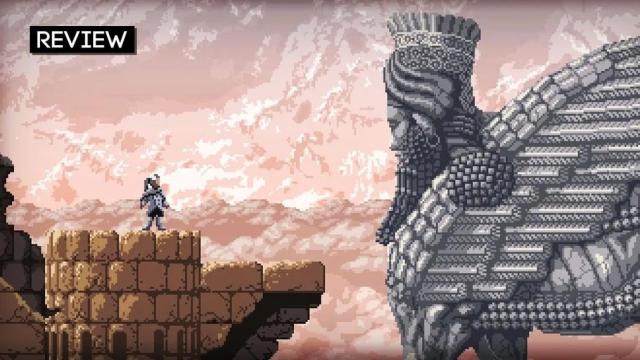There were times early on in Axiom Verge 2 when I wanted to stop playing. I’m glad I didn’t. For all my problems with the game, by the end it had me completely enthralled. Lovely art, haunting music, and a packed constellation of obstacles and shortcuts elevate an often frustrating side-scrolling gauntlet into a worthwhile and occasionally sublime experience. There are plenty of Metroidvanias out there that evoke bygone gaming eras, but indie creator Tom Happ’s personal spin on the nostalgia-fuelled genre continues to stand above most of the rest of the field.
After single-handedly creating its 2015 predecessor, Happ spent the past six years working on Axiom Verge 2 and then, following much anticipation, mystery, and a few delays, surprise-launched it on PS4, PC, and Switch last week. In some ways it feels fitting. Where the first game received a big marketing push as part of PlayStation’s then-annual Spring Fever indie showcase, the somewhat more sophisticated and experimental followup dropped out of nowhere, relatively speaking, beckoning players to go in fresh and discover its secrets for themselves.
This is how I approached Axiom Verge 2. I was essentially expecting a more polished, optimised, and ambitious version of what the first game had already accomplished. I was relieved, though also occasionally pained, to find something that built out from rather than just on top of what had come before. New abilities, a more organic map, and constant dimension shifting made me fall in love with Axiom Verge 2, but only after I learned to avoid its pitfalls in a way I never had to with the first game. Where Axiom Verge was an impressively crafted homage to Metroid that was largely free of that game’s frustrations, Axiom Verge 2 feels like an original 2D exploration game that just happens to be littered with irritating artifacts from Nintendo’s genre-creating NES classic.
[review heading=”Axiom Verge 2″ image=”https://www.gizmodo.com.au/wp-content/uploads/sites/3/2021/08/20/753b4a877f7ce1002518d28e1431a424.jpg” label1=”BACK OF THE BOX QUOTE” description1=”A pickaxe? Against that thing? ” label2=”TYPE OF GAME” description2=”One your friend tells you gets good eventually” label3=”LIKED” description3=”Gorgeous art, great soundtrack, rewarding exploration ” label4=”DISLIKED” description4=”Tedious combat and uneven pacing ” label5=”DEVELOPER” description5=”Tom Happ Games” label6=”PLATFORM” description6=”PS4, PC, Switch (Played)” label7=”RELEASE DATE” description7=”August 11, 2021″ label8=”PLAYED” description8=”About 9 hours, finishing the main game and occasionally venturing off the beaten path” ]
Axiom Verge 2 bears loose connections to its predecessor, but it’s also self-contained enough that you can approach it with no knowledge of the original. You play as corporate billionaire Indra Chaudhari as she investigates the disappearance of a research colony in the Arctic. Her search quickly finds her transported to an alternate version of Earth filled with enemy robots and the remnants of a lost civilisation, where her trusty pickaxe and boomerang are sure to come in handy. Dazzling pixel art and chiptune-y beats return, but this time enriched by more layers and variation. Intricate configurations of wires and metal are juxtaposed with mythical backdrops of giant statues and celestial cloudscapes while human vocals mix with earthly instruments to create otherworldly intrigue.
At first the landscape is very naturalistic, with green fields and rocky cliffs giving way to dark caverns and underground lakes. But soon enough you discover the Breach, a demake dimension filled with neon colours and animalistic monsters, which you navigate using an insect-like drone that makes movement and exploration a joy. It’s a big part of what makes Axiom Verge 2 feel like more than just more of the same.
Unlike the first game, Axiom Verge 2 places a much bigger emphasis on exploration than combat. Your arsenal is geared more toward solving light puzzles and unlocking new passages than blasting enemies to hell. In fact, there are barely any real projectile-based armaments in the game outside of your initial boomerang. Instead, a hacking ability lets you sabotage or take over robot enemies while a series of upgrades for your drone make it the real star of the show.
At first the drone, which is remote controlled, is primarily for exploring tight spaces or scouting ahead while Indra stays safely out of the fray. Later, however, it gets more abilities, including a grappling hook that lets you swing through tunnels with Spider-Man-like abandon. Eventually, Indra herself even gets upgraded enough to transform into the drone at will. This is a recurring theme throughout the game: Discrete tactics and mechanics subtly shift and evolve as you play until eventually they blend seamlessly together. It’s a satisfying testament both to the eventual feeling of mastering the game and its sprawling map and just how well many of its distinct pieces come together by the end.

The way Axiom Verge 2 doubles down on exploration and navigation tools does come at a cost, however. When its combat isn’t frustratingly challenging, it’s straight-up boring. In fact, there’s a strong case to be made that avoiding fights as much as possible is the best way to play. And boss fights, unfortunately, do little to change this.
Despite the dramatic flair with which they’re presented, bosses are almost unanimously little more than button-mashing fests. My preferred strategy? Smacking them with my melee weapon as furiously as possible as often as possible and hoping it was enough to defeat them before all my health ran out. Happ’s pixel art is often breathtaking, and whenever a giant robot appeared on screen I was blown away. And then I kept on moving. Thankfully, most bosses in the game are optional and can be bypassed.
Needing to learn to prioritise exploration over combat is partly why I had such a difficult time with Axiom Verge 2 in the beginning. I kept trying to play it like the previous game and all the Metroidvanias I’ve played that came before it. I’d enter an area, try to kill everything I found, and then scour the boundaries looking for secrets and alternate paths. Mostly this just got me killed, and the more systematically I tried to approach mapping the game’s world, the more roadblocks I ran up against.
At its core, the world of Metroid — a clear influence on the Axiom Verge games — is a series of big and small tubes interconnected. The result is a claustrophobic maze, but also one that’s easy to wrap your mind around. To its credit, Axiom Verge 2 has tried to break away from that artificial mould with a map composed of various zones and mini-biomes that stretch and run together in ways that breathe life into its mysterious, dying world, but the result can also be harder to visualise and navigate than your standard virtual labyrinth.

Axiom Verge 2 tries to address this with a compass that points you in the general direction of objectives, but it only goes so far. For much of the first half of the game, the upgrades needed to overcome obstacles and ascend to new locations are intuitively scattered around. More than once I found myself stuck on one edge of the map only to find the solution all the way across on the other. And without fun combat or a progression grind to reward fighting your way from place to place, backtracking quickly became a chore. This is lessened once you get an upgrade that lets you fast-travel between save points, a feature that should probably just be open to players from the start.
Ultimately though, Axiom Verge 2 will reward those who stick with it. Introduced sparingly in the first couple of hours, the Breach eventually takes centre stage and when it does, the game’s alien world takes on a life of its own. The thrill of a Metroidvania lies in taking that which repetition has made familiar and recasting it as new and alien thanks to a new way of interacting with the world. Being able to climb a wall that was originally insurmountable or blow up rocks that were previously blocking your path isn’t just rewarding in the moment; it also transforms everything around it as you probe old locations for new secrets. Building off of the original’s Secret World, Axiom Verge 2’s Breach creates a mirror reflection of the existing map that adds an entire new layer of permutations dense with possibilities. The ways in which the Breach and the “real world” of the game interact with each other are thrilling to discover, and help make Axiom Verge 2, for all the retro trappings of its visuals and music, feel like anything but a relic of the genre’s past.
I’m not surprised Axiom Verge 2 has been as divisive as it has, generating a range of different receptions and conflicting opinions. I was conflicted myself until the credits started to roll. Now I’m just counting down the next half a dozen years until Axiom Verge 3, and whatever bold new surprises Tom Happ may have in store for us then.

Leave a Reply